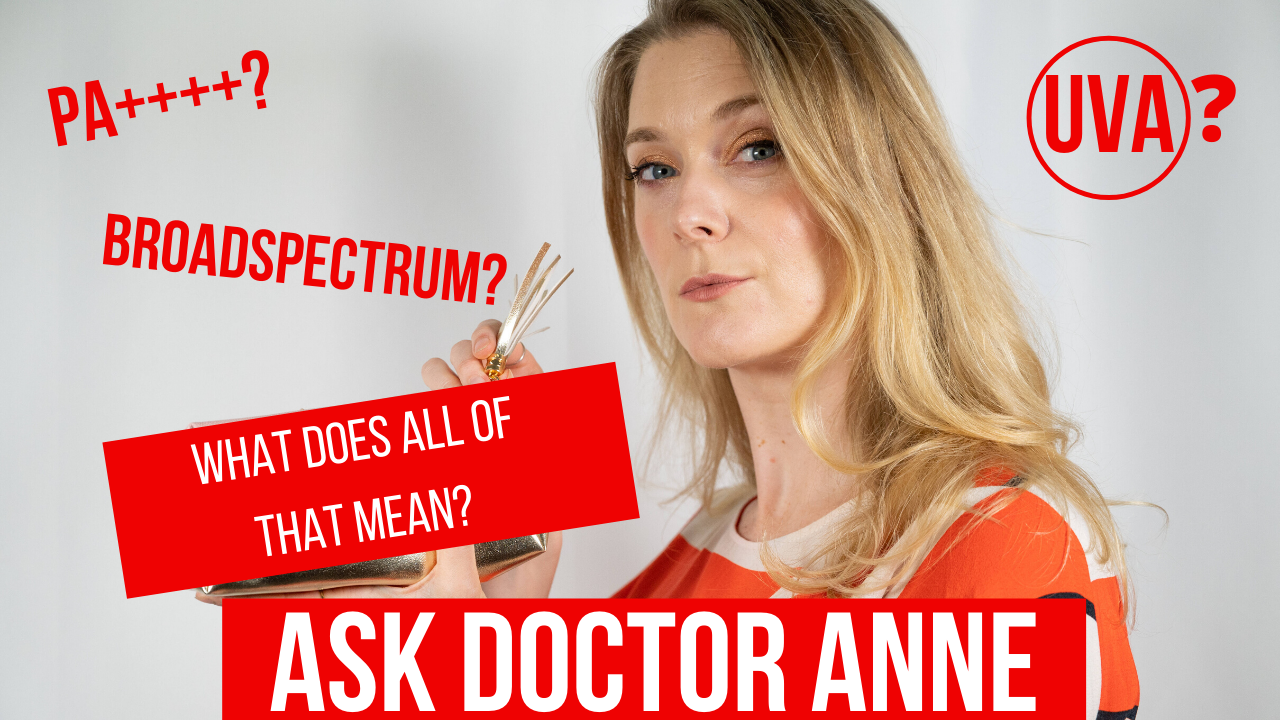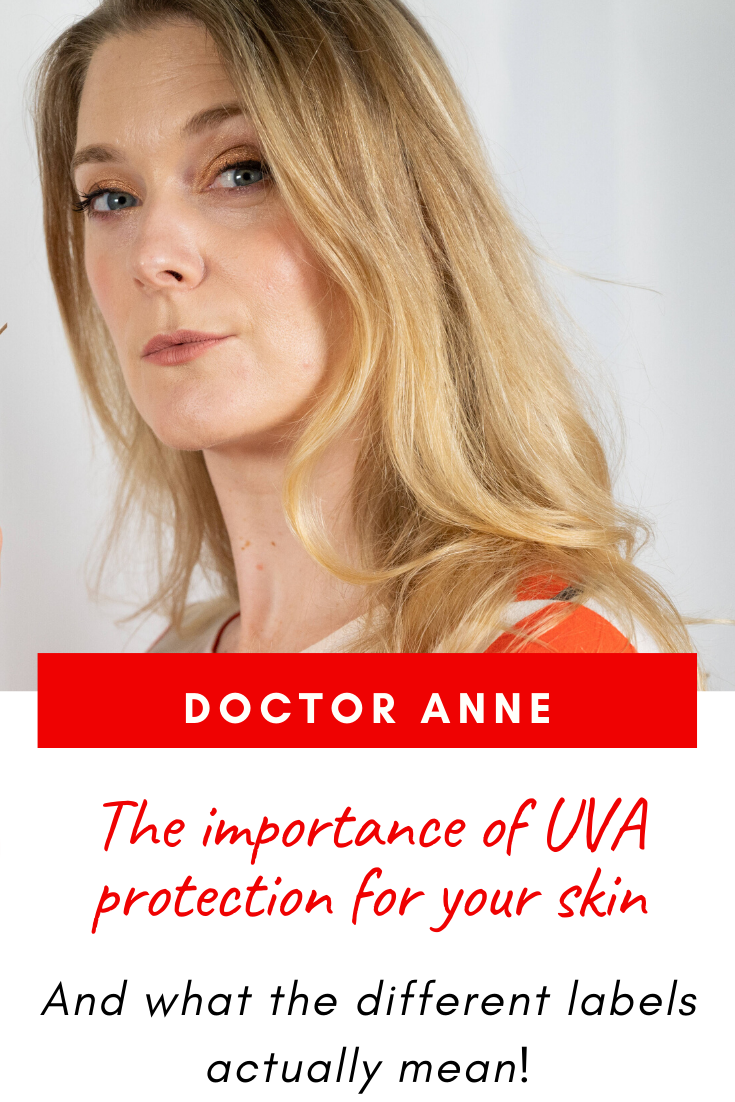In the previous videos I made on sunscreen (just type sunscreen in the search bar), I often mentioned „broad spectrum“ sunscreen or talked about the UVA and UVB protection
What I did not yet adress in depth though is why UVA protection is so important and how you can identify sunscreens that offer adaequate protection – because it sadly isn´t as easy as looking at the SPF.

I had so many questions on that topic that I decided to dedicate a whole video of the Ask Doctor Anne – Your sunscreen questions answered series on the topic.
But first a quick recap
What does UVA, UVB and SPF mean?
UV stands for Ultra-Violet and describes rays with a shorter wavelength than the visible light, which means we can´t see them with the bare eye.
There are three different forms of UV rays, UVA with a wavelength of 320 to 400 nm, UVB with a wavelength of 280 to 320 nm and UVC with a wavelength of 100-280 nm.
UVC is absorbed in the atmosphere, so it doesn´t really play a huge role in our everyday life, but is often used in science for stimulating fluorescence or things like that.
UVB ist the one that got the most attention throughout the years, as it is responsible for long time erythema aka sun burn and skin cancer. This is why the well known SPF on the bottle only refers to UVB protection – no one actually cared about UVA.
Why was that a mistake?
Why is UVA protection important?
Well, UVA not only makes up the majority of UV rays we are exposed to, it is responsible for 90-95% of all UV rays that reach the earth surface, but it can also penetrate deeper into the skin. Other than UVB, which will only reach the Epidermis, it can go as deep as the Dermis where it can destroy our collagen.
Destroyed collagen equals saggy skin or in other words: UVA is responsible for skin A-ging as in wrinkles, hyperpigmentation and loss of firmness. It is also mainly responsible for A-llergic reactions triggered by the sun, something I have talked more in depth about here and contributes to the development of skin cancer.
Doesn´t sound too good, hm?
On top of all that, it is present all year round, in the midst of winter as well as in summer and that from the moment the sun rises to the time it sets. Yes, it is strongest in summer and on midday, but even on a winter morning there is still enough to initiate changes in the skin – Wear your SPF all year round, people!
Oh, and other than UVB rays it can penetrate through glass – being indoors will not protect you.
How is UVA protection measured?
Other than SPF, which measures the time until you burn, UVA is measured through PPD.
PPD stands for Persistent Pigment Darkening and measures the protection not against sun burn, but against your skin darkening through UV exposure.
This can be done both „in vivo“, which means on living human beings that protect one part of their skin and not the other and then they are exposed to UVA rays and the difference is measured, or „in vitro“, which means on cells in a lab.
And that is where the first difference to SPF comes into play – SPF is always measured the same. PPD is measured mainly in vitro in the EU and mainly in vivo in Asian countries, with some European companies like Bioderma and la Roche Posay using the „in vivo“ method to complete the confusion. Thankfully the results of in vivo and in vitro testing seem to be comparable.
Another way to look at it is the absorption above a critical wavelength of >370 nm, which considers the fact that there are different kinds of UVA rays, UVA1 and UVA2, at different wavelengths. To be labelled as broad spectrum in the US, at least 10% of the total absorbance must be above 370 nm.
But to be broad spectrum in the EU, in addition to the absorption above critical wavelength UVA protection has to be at least 1/3 of the UVB protection determined by SPF, so a sunscreen can be broadspetrum in the US, but not in the EU.
Confused? And that isn’t everything.
Different ways UVA protection is marked on the label
In the US, a sunscreen that offers UVA protection has „broad spectrum“ or „critical wavelength“ written on the packaging, but there are no means to tell just how much protection it will offer.
In the EU, you will find different markers. One is the „UVA in a circle“, which can only be used if UVA protection is at least 1/3 of the SPF, so it will tell you that the SPF 50 with the UVA in circle has minimum a PPD of 16,6666667. Maybe more, you couldn´t tell.
Some companies will also print the PPD on the packaging, so the before mentioned SPF 50 could also have PPD 16 instead of the UVA in circle.
La Roche Posay and Bioderma, despite being European, will print UVA and then the number, so here you see what you get in terms of protection.
Great Britain on the other hand uses the Boots Star Rating to indicate UVA protection, which similar to the UVA in circle thing refers to UVA/UVB ratio. But you need 0,6 to 0,79 to get a „good“ (three stars), 0,8 to 0,89 for „superior“ (four stars) and more than 0,9 for „Ultra“ (five stars).
Asian sunscreens however use the PA+ rating. PA+ is PPD 2-4, PA ++ is PPD 4-8, PA +++ is PPD 8-16 until PA ++++, which means 16 plus and is the highest available ranking. Just for reference, a European broadspectrum SPF 50 also has at least a PPD of 16.
How much UVA protection is enough?
Sadly I don´t have a conclusive answer for that – PPD 10 will block around 90% of UVA rays, which is considered enough for everyday use, but if hyperpigmentation or sun allergy are an issue, it might not be enough for you.
And, as it is the same with SPF, to really get the labelled protection you have to apply enough and reapply frequently, something most of us struggle with. But that is a topic for an upcoming video.
For now I would say: the higher the better, so you will never see me wearing less than a European broad spectrum SPF 50 or an Asian PA++++ (these are my current favorites), and that is what I recommend you do as well.



